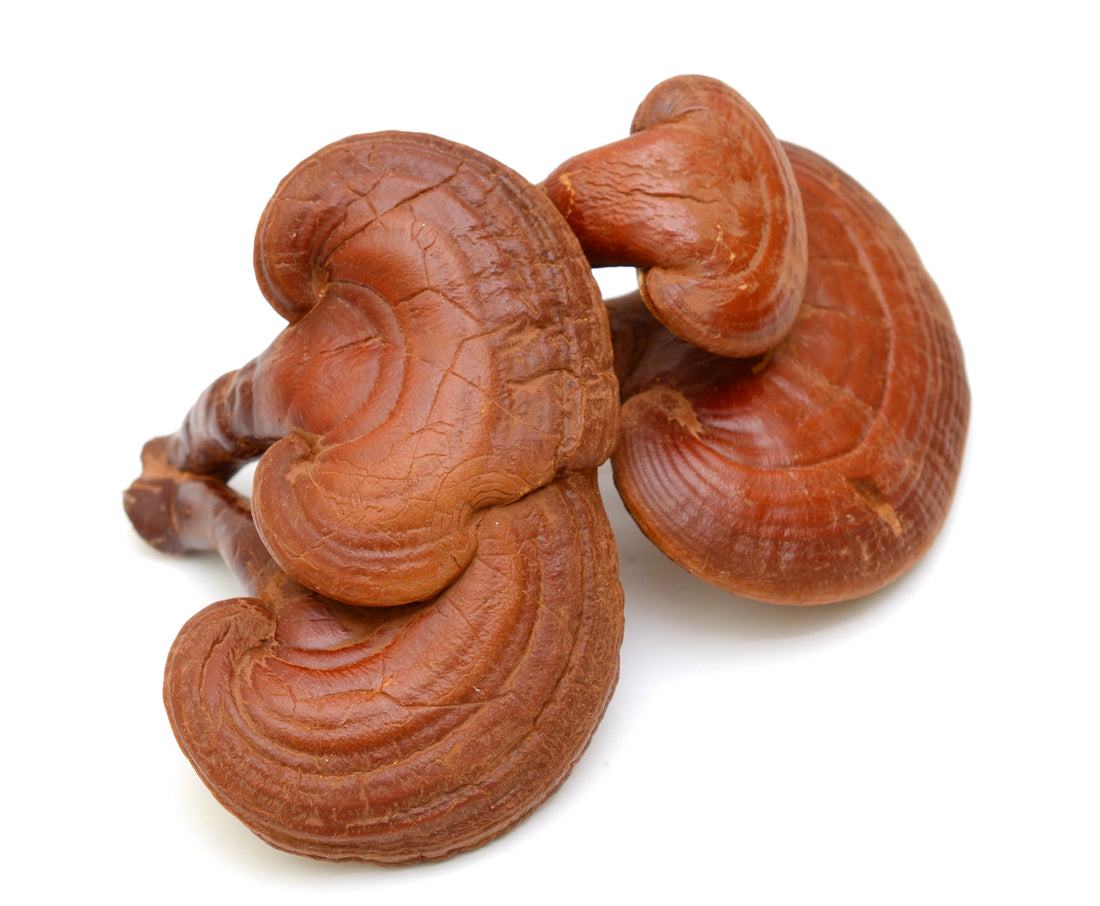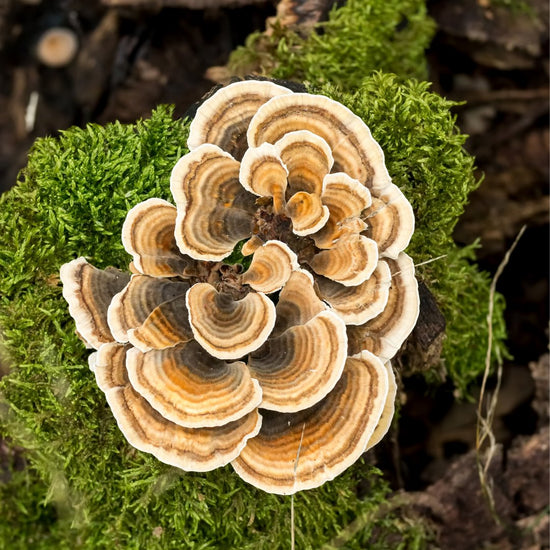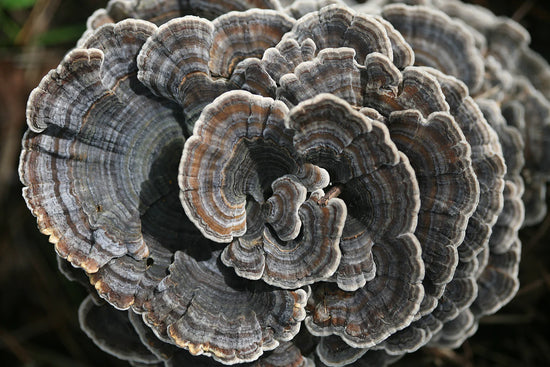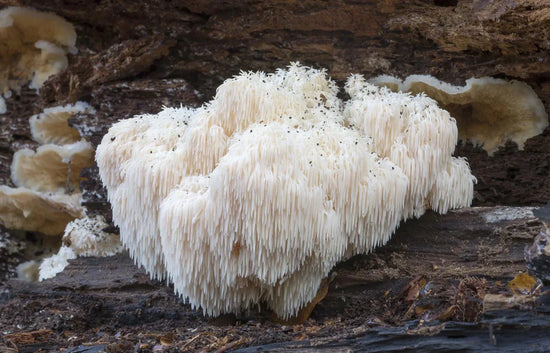Reishi Mushroom Look-Alikes: Identification Guide

Are you a mushroom enthusiast with a passion for foraging in the wild? If so, then the mystical world of reishi mushrooms is sure to captivate your imagination. Revered for their numerous health benefits and revered status in traditional medicine, reishi mushrooms are truly nature's hidden treasure. But, be warned, for there are impostors lurking amidst the foliage, mimicking the coveted reishi mushroom. In this blog, we will embark on a journey of discovery, learning how to discern genuine reishi mushrooms from their cunning lookalikes. So strap on your hiking boots, sharpen your senses, and let's delve into the enchanting realm of reishi identification in the wild.
Ready to start carving the path to a healthier future? Check out the reishi mushroom supplements available at Mushroom Revival. We believe mushrooms are the way forward for holistic healing!
Learn All About The Reishi Mushroom Species
Calming reishi mushroom makes the perfect addition to your stress and sleep management toolkit. Knowing how to spot Reishi mushrooms out in the wild can help you go right to the source to make your tea or mushroom extract.
Reishi mushrooms are a large family of mushrooms - in North America alone there are over 16 species of reishi. So, let's meet the brothers, sisters, uncles, and aunts of the calming reishi mushroom. All reishi species are safe for consumption, so you don't need to worry too much about telling them apart - There are no poisonous look-alikes! It’s also important to note that there are many names for reishi - Ganoderma lucidum, lingzhi (Chinese), and reishi (Japanese). Reishi mushrooms are not gilled mushrooms, their underside looks like a small sponge with dots.

Ganoderma Lucidum
Ganoderma lucidum, commonly known as Reishi or Lingzhi, is a species of functional mushroom renowned for its potential health benefits. Ganoderma lucidum is the mushroom commonly used in ancient Chinese holistic practices, and nicknamed the “Mushroom of Immortality”. It is a bracket fungus that belongs to the genus Ganoderma. Reishi mushrooms are predominantly found in various regions of Asia, including China, Japan, Korea, and other parts of East Asia. They are typically associated with decaying hardwood trees, such as oak and maple, and can also be found in forests and wooded areas with rich organic matter. Reishi mushroom has a long history of use in traditional Chinese holistic practices and has gained popularity worldwide for its potential immune-enhancing and adaptogenic properties.
Lingzhi is the Chinese name for the Ganoderma lucidum, or reishi mushroom, so you might hear the reishi mushroom described as Ganoderma lingzhi.
Reishi in China used to be called Ganoderma lucidum but based on DNA sequencing, they figured out it's actually Ganoderma lingzhi and Ganoderma lucidum is another species in Europe.
Lucidum means light, referring to the shiny cap of the mushroom, whereas lingzhi is simply the Chinese name for reishi.
Mushroom Revival uses Ganoderma lingzhi in their Reishi Mushroom supplements collection!
Reishi Mushroom Look Alike
Ganoderma Tsugae
Ganoderma tsugae is a species of mushroom commonly known as Hemlock Reishi or Eastern Reishi. It can be identified by its shelf-like growth pattern, with a reddish-brown to dark brown cap that has a shiny, varnished appearance, distinguishing it from the matte surface of Ganoderma lucidum (reishi). Additionally, Ganoderma tsugae is often found growing on coniferous trees, particularly hemlock, while Reishi is more commonly associated with hardwood trees.
Ganoderma Capense
Ganoderma capense is a species of mushroom known for its unique appearance and medicinal potential. It can be distinguished from reishi mushrooms by its distinctive fan-shaped cap with a reddish-brown coloration, often accompanied by prominent concentric rings, contrasting with the smoother and more lacquered appearance of reishi’s cap.
Ganoderma Applanatum
Ganoderma applanatum, commonly known as Artist's Conk, is a bracket fungus characterized by its large, flat, and woody fruiting body that resembles a shelf. It can be differentiated from Reishi by its tan to brown underside color, where as Reishi is typically red.
Ganoderma Carnosum
Ganoderma carnosum, also known as Velvet-Top Fungus, is a species of mushroom with a velvety or fuzzy cap surface. It differs from Ganoderma lucidum (reishi) in its texture, as Reishi has a smooth surface. Additionally, Ganoderma carnosum usually lacks the glossy or lacquered appearance seen in Reishi.
Ganoderma Curtisii
Ganoderma curtisii is a species of mushroom commonly known as Curtis' Ganoderma. It is characterized by its shelf-like growth habit and reddish-brown or white cap with a smooth or slightly cracked surface. In terms of appearance, Ganoderma curtisii can be distinguished from Ganoderma lucidum (reishi) by its smaller size and lack of the characteristic glossy or varnished appearance often seen in Reishi. This species is most commonly found in the southeastern region of the United States.
Ganoderma Resinaceum
Ganoderma resinaceum is a species of bracket fungus with a woody texture and a reddish-brown to dark-brown cap. It can be differentiated from Reishi by its smaller size and lack of the glossy or varnished appearance commonly seen in Reishi.
Ganoderma Sessile
Ganoderma sessile is a species of mushroom characterized by its shelf-like growth habit and brown to reddish-brown cap. Ganoderma sessile differs from Ganoderma lucidum (reishi) in its smaller size and lack of the glossy or varnished appearance typically seen in Reishi. Ganoderma sessile is commonly found in eastern North America.
Ganoderma Oregonense
Ganoderma oregonense is a mushroom species commonly known as Oregon Reishi. It can vary in size from medium to large, and it features a reddish-brown to dark-brown cap with a shiny, varnished surface. In terms of appearance, Ganoderma oregonense can be distinguished from Ganoderma lucidum (reishi) by the presence of a distinct, net-like pattern on the cap, which is not typically observed in Ganoderma lucidum (reishi).
Fomitosis Pinicola
Fomitopsis pinicola, commonly known as the Red-Belted Conk, is a bracket fungus characterized by its distinctive reddish-brown to the dark brown cap. It can be differentiated from Ganoderma lucidum by the absence of a glossy or lacquered appearance and the presence of reddish hues throughout the cap and stem. Additionally, Fomitopsis pinicola lacks the distinct banding pattern often seen in Ganoderma lucidum.
How To Identify Reishi Mushrooms?
Reishi mushrooms mostly grow in East Asia and are one of the easiest ones in the family to identify. For reishi mushroom identification, it has consistent characteristics. If you're ever in East Asia foraging reishi mushrooms in the mountains, you should look for these key characteristics:
Pay Attention To Its Fan Or Kidney Shape
The reishi mushroom has a fan or kidney shape that is easily recognizable. It fans out from a stem, and the fan is rounded and puffy, giving it the appearance of a kidney sometimes. Sometimes it's just growing like an antler, other times it will not have a stem and immediately fan our from a tree, sometimes it will create a round flying saucer shape on top of the stem.
This is what is cool about reishi is it comes in all shapes, sizes and colors!
Look At Their Colors: Red To Orange
Reishi mushrooms have a wide range of color variations, making it more difficult to differentiate between different reishi species. They can come in brighter red colors, deep browns, or vibrant oranges. The reishi mushroom caps can be dull or beautiful depending on the mushroom.
Identify How Shiny It Is
Reishi mushrooms are shiny, a distinct feature of the species. You should always check the surface of the reishi cap to ensure you've got the right guy.
Verify Whether The Bottom Side Is White
The bottom of the mushroom cap should be white, or sometimes a duller gray or beige for older reishi mushrooms. There should not be any gills on the underside of the cap, as reishi mushrooms are not gilled mushrooms.
Confirm Their Size
When reishi mushrooms grow in a facility, they can be around the size of a dinner plate. However, when left to grow in the wild, reishi mushrooms can grow even bigger.
How To Harvest And Store Reishi Mushrooms
When foraging for reishi mushrooms or growing them yourself, pick quality Ganoderma lucidum mushrooms without bug holes or imperfections. You'll find them growing on the roots or base of hardwood trees. Then, you should brush the dirt from your wild mushrooms and place them in a dehydrator. Set the dehydrator to around 110 degrees and leave the mushrooms for 3 hours. The reishi mushroom pore side dries pretty quickly, so it shouldn't take long to get the desired consistency.
Reishi Mushroom Benefits
Now that you know all about harvesting reishi mushrooms, let's take a look at the benefits you can gain by consuming reishi mushroom supplements. It's important to know that you shouldn't eat chopped reishi mushrooms - the texture is chewy and particularly unpleasant. Instead, harvesting reishi's properties by making reishi tea or creating a reishi mushroom extract is best - or try our convenient reishi products made with 100% fruiting bodies and USDA-certified organic!
Provides Immune Support
Reishi mushrooms support the immune system as they contain 1,3 1,6 beta glucans which support the body's production of immune cells and proteins that are important for a healthy immune response.
Supports The Body's Natural Response To Occasional Stress
Reishi mushrooms belong to a group of natural supplements called adaptogens. Adaptogens can support the body's natural occasional stress response. Reishi mushrooms can act like a warm and comforting hand on your shoulder, helping you to let go of what's out of your control.
Supports Relaxation And Healthy Sleep Cycles
Sleep health is vital to our energy, mood, and stress levels. By creating healthier sleep cycles, you can give your body the rest it needs to function at its best. Reishi mushrooms are known for supporting relaxation and your body’s natural transition to sleep. It can be a great addition to your evening rituals!
Supports Cardiovascular Health
Some of the compounds found in Reishi are ganoderic acids A, B, C, and D, lucidenic acid B, and ganodermanontriol. These compounds have shown positive qualities supporting balance and cellular health within the normal heart and cardiovascular system function.
Supports Healthy Inflammatory Responses Post-Workout
Inflammation can lead to delayed onset muscle soreness following your workouts, making it difficult to get your next workout planned. Reishi mushrooms can help support your body's natural responses to occasional inflammation post workout, making recovery more efficient for your next gym or training session! Read here how long it takes for reishi mushroom to work.
FAQ
Still have questions? Here are some more details about reishi mushrooms foraging and where to buy quality products.
Do All Species Of Reishi Offer Equal Benefits?
While different species of Reishi mushrooms share some similarities in terms of their potential health benefits, it is important to note that not all species offer equal benefits. The most extensively studied and recognized species within the Reishi genus is Ganoderma lingzhi.
Other species, such as Ganoderma tsugae and Ganoderma lucidum may have overlapping benefits but could have varying levels of bioactive compounds and potency. Therefore, it is recommended to consult reliable sources and choose reputable supplements or extracts derived from well-studied species like Ganoderma linzhi to maximize the potential benefits, such as Mushroom Revival.
What Is The Ideal Time To Gather Reishi Mushrooms?
The ideal time to gather Reishi mushrooms depends on the specific species and geographical location. However, a general guideline is to harvest Reishi mushrooms when it reaches maturity. In many cases, this occurs during the late summer or early autumn when the mushroom's cap has fully expanded and its spores are ready for dispersal. It is important to note that Reishi mushrooms can vary in growth patterns, so it is recommended to consult local foraging resources or experienced foragers in your region to determine the optimal time for gathering Reishi mushrooms in your specific area.
Where Can I Get Quality Reishi Mushrooms?
You can purchase quality reishi mushroom supplements online through Mushroom Revival’s website. Buying 100% fruiting body supplements is essential when purchasing reishi mushrooms, as this ensures they will not contain any fillers. Quality USDA-certified organic ingredients and extensive heavy-metal testing on each batch make Mushroom Revival’s products some of the best available!
The Bottom Line
Reishi mushrooms have long been touted as the “Queen of Mushrooms” in traditional Chinese holistic practices. Whether you’re out foraging for reishi mushrooms (Ganoderma mushrooms), or opt for the convenience of supplements, adding functional mushrooms is definitely in your best interest. You can also read our guide about identifying lion's mane and turkey tail mushrooms.
At Mushroom Revival you can find a variety Reishi mushroom supplements for your everyday lifestyle. Check out our products to see which mushroom blend is right for you!




























